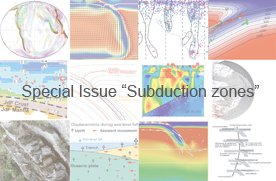Thermal structure and intermediate-depth seismicity in the Tohoku-Hokkaido subduction zones
Abstract. The cause of intermediate-depth (>40 km) seismicity in subduction zones is not well understood. The viability of proposed mechanisms, which include dehydration embrittlement, shear instabilities and the presence of fluids in general, depends significantly on local conditions, including pressure, temperature and composition. The well-instrumented and well-studied subduction zone below Northern Japan (Tohoku and Hokkaido) provides an excellent testing ground to study the conditions under which intermediate-depth seismicity occurs. This study combines new finite element models that predict the dynamics and thermal structure of the Japan subduction system with a high-precision hypocenter data base. The upper plane of seismicity is principally contained in the crustal portion of the subducting slab and appears to thin and deepen within the crust at depths >80 km. The disappearance of seismicity overlaps in most of the region with the predicted phase change of blueschist to hydrous eclogite, which forms a major dehydration front in the crust. The correlation between the thermally predicted blueschist-out boundary and the disappearance of seismicity breaks down in the transition from the northern Japan to Kurile arc below western Hokkaido. Adjusted models that take into account the seismically imaged modified upper mantle structure in this region fail to adequately recover the correlation that is seen below Tohoku and eastern Hokkaido. We conclude that the thermal structure below Western Hokkaido is significantly affected by time-dependent, 3-D dynamics of the slab. This study generally supports the role of fluids in the generation of intermediate-depth seismicity.






